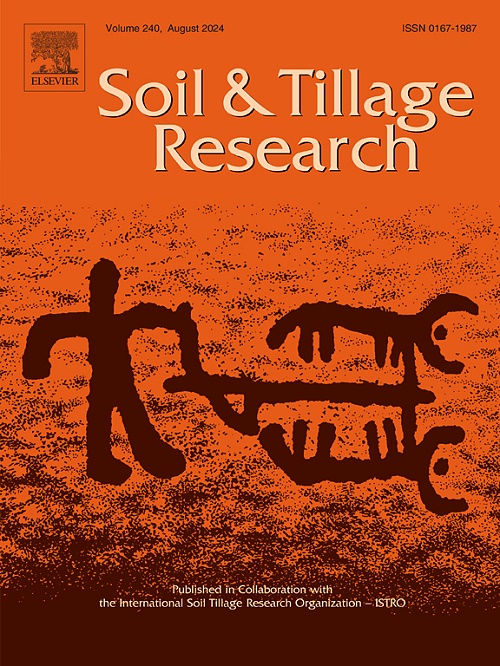保护性耕作对华北平原潮土有机碳的吸收具有多种途径
IF 6.8
1区 农林科学
Q1 SOIL SCIENCE
引用次数: 0
摘要
保护性耕作(少耕+秸秆还田)显著提高了土壤有机碳(SOC)的积累,但碳固存的潜在途径尚不清楚。通过对华北平原16年保护性耕作试验,研究了保护性耕作对土壤有机碳数量和稳定性的影响,并确定了耕作和秸秆管理对0-10 cm表层有机碳固存的调节机制。结果表明,秸秆耕作对土壤有机碳库的影响显著强于耕作。与连作相比,还田还田使土壤有机碳含量平均提高0.55 g kg−1(不稳定性降低12.6% %),还田还田使土壤有机碳含量平均提高0.63 g kg−1(不稳定性降低15.3% %)。相比之下,在所有耕作制度中,与秸秆相比,秸秆还田显著提高了有机碳浓度3.46-3.62 g kg−1,有机碳稳定性提高了34.9-40.8 %。减少耕作频率显著降低有机碳矿化,通过增加容重和非活性孔隙体积,以及降低通气性和持水孔隙体积,促进相对稳定有机碳的积累。秸秆还田显著增加了物理亚组分中有机C的积累,尤其是颗粒内细有机质和大团聚体中矿物伴生有机质,这是土壤有机碳浓度和稳定性增强的主要原因。保护性耕作条件下土壤理化性质对微生物群落丰度的影响存在差异。具体来说,细菌对免耕和减耕有积极的响应,而细菌和真菌都受到秸秆还田的刺激,共同稳定了有机碳。减少耕作频率主要增加了细菌坏死块对有机碳的贡献,而秸秆还田显著增加了细菌和真菌的坏死块C。我们得出结论,保护性耕作通过不同的途径增强了所测试的河流-水土壤的有机碳固存。本文章由计算机程序翻译,如有差异,请以英文原文为准。
Conservation tillage exerts diverse pathways to sequester organic carbon in fluvo-aquic soils of the North China Plain
Conservation tillage (minimal tillage + straw return) significantly enhances soil organic carbon (SOC) accumulation, but the underlying pathways of C sequestration remain unclear. Using a 16-year conservation tillage experiment in the North China Plain, this study investigated how conservation tillage affects SOC quantity and lability, and identified the mechanisms by which tillage and straw management regulate SOC sequestration in the 0–10 cm surface layer. It was found that straw practice exerted a significantly stronger effect on the SOC pool than tillage regime. Compared to continuous tillage, reduced and no-tillage on average increased SOC by 0.55 g kg−1 (with 12.6 % lower lability) under straw removal and by 0.63 g kg−1 (with 15.3 % lower lability) under straw return. By contrast, across all tillage regimes, straw return significantly increased SOC concentration by 3.46–3.62 g kg−1 and SOC lability by 34.9–40.8 % compared to straw removal. Reducing tillage frequency significantly decreased SOC mineralization, promoting the accumulation of relatively stable organic C through increased bulk density and inactive pore volume, along with decreased aeration and water-holding pore volumes. Whereas, straw return significantly increased organic C accumulation in physical subfractions, particularly fine intra-particulate organic matter and mineral-associated organic matter within macroaggregates, which predominantly accounted for the enhancements in SOC concentration and lability. Soil physicochemical properties differentially influenced microbial community abundance under conservation tillage. Specifically, bacteria responded positively to reduced and no-tillage, while both bacteria and fungi were stimulated by straw return, collectively stabilizing SOC. Reducing tillage frequency primarily increased bacterial necromass contribution to SOC, while straw return significantly enhanced necromass C derived from both bacteria and fungi. We conclude that conservation tillage enhances SOC sequestration through diverse pathways in the tested fluvo-aquic soils.
求助全文
通过发布文献求助,成功后即可免费获取论文全文。
去求助
来源期刊

Soil & Tillage Research
农林科学-土壤科学
CiteScore
13.00
自引率
6.20%
发文量
266
审稿时长
5 months
期刊介绍:
Soil & Tillage Research examines the physical, chemical and biological changes in the soil caused by tillage and field traffic. Manuscripts will be considered on aspects of soil science, physics, technology, mechanization and applied engineering for a sustainable balance among productivity, environmental quality and profitability. The following are examples of suitable topics within the scope of the journal of Soil and Tillage Research:
The agricultural and biosystems engineering associated with tillage (including no-tillage, reduced-tillage and direct drilling), irrigation and drainage, crops and crop rotations, fertilization, rehabilitation of mine spoils and processes used to modify soils. Soil change effects on establishment and yield of crops, growth of plants and roots, structure and erosion of soil, cycling of carbon and nutrients, greenhouse gas emissions, leaching, runoff and other processes that affect environmental quality. Characterization or modeling of tillage and field traffic responses, soil, climate, or topographic effects, soil deformation processes, tillage tools, traction devices, energy requirements, economics, surface and subsurface water quality effects, tillage effects on weed, pest and disease control, and their interactions.
 求助内容:
求助内容: 应助结果提醒方式:
应助结果提醒方式:


